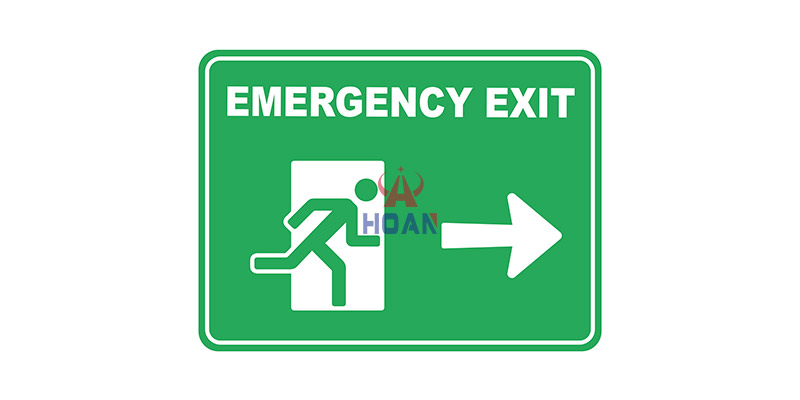An emergency exit sign is a specially designed device for buildings, with its core mission being to clearly indicate the location of emergency exits. In emergencies such as fires, power outages, or natural disasters, it enables people to quickly locate escape routes, serving as a ‘beacon’ guiding life evacuation within the building's safety system. Whether in shopping malls, office buildings, factories, schools, or other venues, it is an indispensable safeguard, forming the foundational configuration for ensuring personnel safety.
Its most critical function is to provide visual guidance to facilitate safe evacuation. During emergencies, chaotic environments can severely impair people's judgment. However, emergency exit signs, with their prominent markings, can cut through the chaos and serve as the ‘command centre’ for evacuation actions. They are an indispensable component of building safety facilities, directly impacting whether people can quickly and orderly evacuate dangerous areas.

LED Bulbs: These feature energy efficiency, long lifespan, and high brightness. In normal conditions, they maintain visibility with low energy consumption; in emergencies, they can instantly emit bright light, even penetrating smoke-filled environments to ensure the sign remains clearly visible.
Traditional fluorescent tubes: These provide continuous lighting and were widely used in emergency exit signs in the past. Although they have lower energy efficiency and brightness compared to LEDs, they can maintain stable illumination, ensuring the basic guidance function of the sign.
Main Power Supply: Connected to the building's electrical grid, it provides power for the sign's daily operation. As long as the building's power supply is normal, it continuously supplies power to the signs, maintaining their illuminated state, serving as the energy source for the signs' ‘routine operations.’
Backup Battery: Activates automatically when the main power supply is interrupted. According to standards, it typically ensures the signs continue to operate for 90 minutes or more, providing sufficient time for evacuation, serving as the critical backup for the signs' ‘emergency operations’ during power outages.
Durable Housing: Typically made from fire-resistant materials such as polycarbonate. In emergencies like fires, where high temperatures and physical impacts are common, this housing can withstand damage, ensuring the sign's structural integrity and continued functionality as a guide.
Standard Symbols/Letters: Features the universal ‘EXIT’ letters or internationally recognised exit symbols. People from different linguistic backgrounds can quickly identify exit locations using these signs, eliminating language barriers that may hinder evacuation.

The sign is connected to the main power supply and maintains illumination using low-power LED lights (if LED-type). At this time, the backup battery remains in charging mode, ready to respond to sudden power outages. This ensures that if the main power supply malfunctions, the sign can seamlessly switch to emergency mode.
When the main power supply is interrupted (e.g., due to fire-induced circuit damage or natural disasters damaging power facilities), the built-in sensors detect the power outage, and the backup battery immediately activates. Whether using LED or fluorescent tubes, the signs continue to emit light under battery power, ensuring they guide people to escape routes even in dark or extreme environments.
High-brightness light sources (LEDs): The high brightness of LEDs can penetrate smoke and darkness. The dense smoke produced by fires significantly reduces visibility, but LED light, with its intensity advantage, can potentially create a visual pathway through the smoke, making the sign visible.
Photoluminescent material options: Some signs use this material, which absorbs light and stores energy during the day and emits light autonomously in the dark. Without relying on electricity, they enhance sign visibility, providing an additional layer of assurance for escape guidance.
Seamless switching between primary and backup power sources prevents power supply gaps in signs. When the primary power source malfunctions, the backup battery takes over, ensuring continuous illumination and uninterrupted guidance—the foundation for stable sign performance.
Housing Protection: Fire-resistant and impact-resistant housing ensures the sign maintains structural and functional integrity under harsh conditions such as high temperatures in fires or impacts from falling objects, preventing easy damage.
Backup Battery Lifespan: Meets industry standards for runtime duration, ensuring sufficient power to support sign operation after an emergency power outage, providing full protection for personnel evacuation.
High-Contrast Colours: Common choices include red and green, which are easily noticeable to the human eye. During emergencies, when people are panicking and scanning their surroundings, high-contrast colours can quickly attract attention, making the sign the focal point for escape guidance.
Standardised Symbols: Universal ‘EXIT’ letters and exit symbols transcend language barriers. Regardless of location or language, people can recognise them, ensuring the sign's guidance function is globally applicable.

Signs must comply with standards set by organisations such as the NFPA (National Fire Protection Association) and IEC (International Electrotechnical Commission). Criteria such as brightness, battery life, and material fire resistance must meet standard requirements. Such signs are recognised in most regions worldwide, ensuring basic safety performance.
Signs must comply with the building codes of the location where the building is situated. Due to differences in climate and building characteristics, different regions have varying requirements for the installation location, brightness, and battery life of emergency exit signs. By adhering to local regulations, signs can legally and effectively fulfil their intended purpose within local buildings.
Understanding the principles facilitates maintenance work. Regularly inspect the main and backup power sources, light-emitting components, and housing condition to promptly identify and address issues such as battery depletion or component damage, ensuring the signs remain operational at all times to safeguard the safety of building occupants.
Understanding the principles enhances efficiency during emergency evacuations. Familiarising oneself with the signs' operational logic in everyday situations enables swift trust and following of the signs' guidance during emergencies, reducing panic and confusion, and increasing the likelihood of safe evacuation.
Emergency exit signs rely on the coordinated operation of components such as light-emitting elements, power supply systems, and housing markings. Leveraging features such as automatic power switching, high reliability, and high visibility, they operate stably in various scenarios. From building managers to users, understanding their principles facilitates maintenance and efficient evacuation. Selecting compliant, high-quality emergency exit signs is a critical measure for strengthening building safety defences and safeguarding life evacuation pathways.